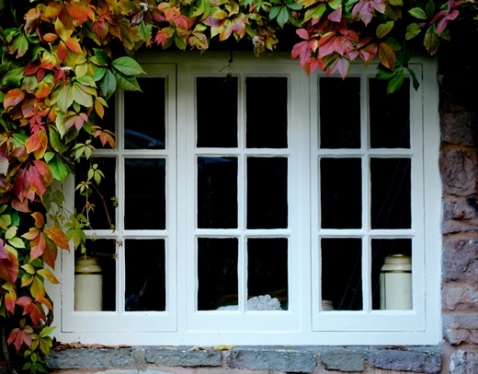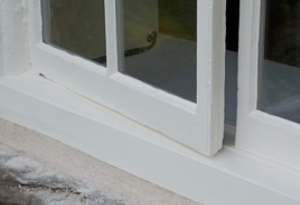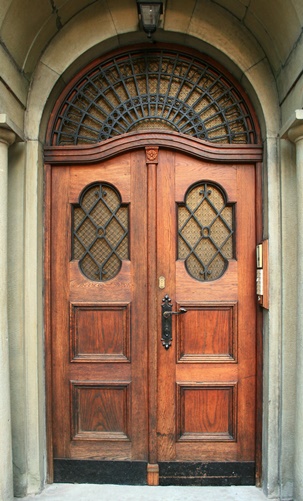Linseed Oil Paints and Mastics
Applications and Limitations
Peter Kaczmar
 |
|
| Above and below right: a timber casement window painted with a linseed oil paint (Photo: Matthew Evans, Welsh Heritage Décor) |
At the start of the last century wood-coating technology enjoyed a period of relative stability when little energy was expended on developing new or improved coatings.
Then, joinery was manufactured from large-sectioned, slow-grown wood and protected with flexible lead-based paints which seldom showed the types of failure that have become so characteristic of their modern equivalents.
Based on the frequency of observed failures, one could be forgiven for saying that today’s coating technology seems to have taken a step backward. This apparent decline in the performance of wood coatings is often blamed on shifts in attitudes in silviculture as timber made the transition from abundant building commodity to scarce and valuable resource. The consequence was that the definitions of acceptable timber quality were redefined to maximise the use of a shrinking resource.
This in turn placed seemingly unrealistic demands on existing coatings, which were expected to perform well despite the fact that the nature of the substrate had changed. This is reflected in our historic buildings, where the original woodwork was generally manufactured from large-sectioned, slow-grown, and hence stable, temperate hardwoods which do not exert the same demands on paint coatings as today’s more rapidly grown counterparts.
In reality, this is an oversimplification because it does not take into account legislative pressures against the use of lead paints, which began as early as 1921 when the International Labour Organisation, in recognition of the toxicity of these products, implemented a convention restricting the use of white lead (basic lead carbonate) in paints.
These concerns culminated in the establishment of environmental legislation implemented by the European Commission REACH (registration, evaluation, authorisation and restriction of chemical substances) regulations in 2006. The REACH regulations allow the manufacture and use of white-lead paint only under licence in controlled and special circumstances for the repair and restoration of Grade I and II* listed historic buildings (Category A B and C(S) in Scotland) to enable the use of authentic finishes. Strict regulations apply to its use and the general sale of lead paint in the UK is prohibited.
LEAD-FREE PAINTS
 |
Against this backdrop, the wood coatings industry was forced to adapt and manufacturers responded by developing new types of coating, including some systems in which the lead component (lead carbonate) was substituted with titanium dioxide as the alternative pigment.
One of the main advantages of lead carbonate is that it reacts with linseed oil to produce fatty acid soaps which are tough and elastic and also have good wetting properties. This is arguably the principal reason why white lead was so widely used for the protection of wood substrates: it could produce a resilient, relatively impermeable protective film capable of responding to in-service movements of the wood caused by changes in air humidity and substrate moisture content.
The inherent ability of the old lead-based paints to accommodate movement in the substrate was the key to their success when used to protect exterior wood. Formulation technology has responded to restrictions in their use by developing alternative formulations, among them the acrylic and vinyl-based systems and polyester products which led to the development of ‘traditional’ alkyd systems.
THE RISE OF ‘COMPLIANT COATINGS’
In many ways history is now repeating itself: in just the same way as health and safety controls signalled a radical change in the direction of developments during the 20th century, the imposition of environmental legislation set into motion further changes at the start of the 21st. The recent changes stem from two European directives on volatile organic compounds (VOCs). The first, the Solvent Emission Directive (SED) 1999/13/EC, has been fully implemented since 2007 and places limits on installation or plant facilities according to total annual VOC emissions. The second, the Paints Directive (PD/DECO) 2004/42/EC, applies to coatings for use on buildings, their fittings and associated structures as well as products for vehicle refinishing. It divides the coatings into 12 subcategories and sets VOC limits for each one.
These directives have promoted the development of a wave of ‘compliant coatings’ including water-borne dispersions, hybrid products and high-solids coatings. The growing availability of such products has gradually changed the way that modern consumers perceive the role and performance of protective coatings for joinery. This has been especially noticeable in the case of the so-called ‘microporous’ or ‘breather’ paints, which have proliferated in response to the development of water-based compliant coatings.
The notion of micro-porosity stemmed from the need to control and reduce the build-up of moisture in joinery to below 21 per cent, which is generally accepted as the point at which timber becomes susceptible to attack from wood-destroying organisms.
Before the advent of micro-porous coatings, alkyd paints were the predominant type of coating for the protection of window joinery. Alkyd resins are polyesters which have been chemically reacted with a drying oil. This process results in the formation of a three-dimensional interconnecting network of molecular chains which resists the passage of water and forms a hard film. It has the benefit of being easy to clean with solvents and is less prone to sticking or blocking when freshly painted. However, its main drawback is that it becomes brittle with age, becoming progressively less responsive to dimensional movements in the woodwork. When this occurs, cracking of the paint film around joints is the usual result, allowing rainwater to be drawn into the wood by capillary attraction at the point of fracture.
Once inside, the water has no effective means of being vented out since it cannot reemerge past the alkyd paint. The result is that moisture builds up within the fabric of the joinery to a point where it can both trigger the development of rot and interfere with the surface adhesion of the intact coating, causing its eventual delamination in the form of peeling and flaking – a scenario which is all too familiar in the context of restoration and repair work.
The production of alkyd paints has suffered a decline with the rise of waterborne compliant paints in much the same way as the invention of paints based on synthetic resins signalled a similar decline in the use of linseed oil paints. Against the backdrop of current VOC legislation this may seem surprising, given that the production of linseed oil paints offers a VOC-compliant alternative with less embodied energy than paints based on synthetic resins.
LINSEED OIL PAINTS
Linseed oil is a carrier which was commonly used in paint formulations until the mid-20th century, and is still often used in alkyd systems to make the paint more fluid, transparent and glossy. It is available in varieties such as cold-pressed, alkali-refined, sun-bleached, sun-thickened, and polymerised (also known as stand oil).
 |
|
| In many European countries, linseed oil is a traditional finish for fine joinery where protected from the weather. |
The use of linseed oil paint can offer significant advantages over synthetic resin systems, not least in terms of longevity. According to some accounts it can last 15 years or more without maintenance. This is attributable to the fact that it is more ‘extensible’ (more elastic, less prone to brittleness) and can better accommodate shrinkage or swelling movements in wood before requiring maintenance.
However, such performance benefits seldom come without a price. In the case of linseed oil paints, they are more difficult to apply on account of their lower viscosity. Application is also labour-intensive due to the attention required to avoid runs and a propensity of the finish to incorporate dust and surface imperfections (nibs) because it tends to ‘creep’ over them.
Linseed oil paints must also be applied very thinly to avoid wrinkling on drying and have a tendency to skin in the can. Once cured they are softer and may have inferior resistance to surface abrasion, although this can be offset by fortifying the formulation with resin additives such as pine rosin, amber or semi-fossilised Kauri pine resin.
Arguably the greatest disadvantage of linseed oil paints is their tendency to disfigure on account of the growth of surface moulds and yeasts. This is probably caused by the paint allowing moisture into the substrate, enabling natural sugars, present in the wood, to migrate to the surface where they can be assimilated by the microorganisms, but it may also be caused by the build-up of dirt deposits which can provide another source of nutrients and minerals.
When used as a wood finish on its own, linseed oil dries slowly and shrinks little upon hardening. It does not deposit a discrete film over the surface as varnish does but is absorbed into the surface of the wood, leaving a shiny but not glossy surface that enhances the visual contrast of the grain of the wood. A linseed oil finish is easily repaired but offers little or no protection against scratching. Linseed oil finishes are less effective than paints based on synthetic resins at preventing the uptake of moisture, in either liquid or vapour form, into the joinery.
BURNT SAND MASTIC AND LINSEED OIL PUTTY
The ingress of moisture into exterior joinery not only occurs through open joints or via the external coating but can also occur at masonry junctions. Traditionally these routes of potential ingress were sealed using linseed oil putty made from oil and whiting (chalk) or burnt sand mastic made from roasted sand mixed with lead-based ‘driers’ (now replaced with synthetic driers) and chalk.
The advantage of burnt sand mastic over linseed oil putty as a peripheral sealant around window and door frames is that linseed oil putty oxidises and becomes brittle with age and exposure to air, a process which can be slowed, though not prevented, through the application of a paint coating over the putty.
Burnt sand mastic can be slow to set if made without driers and forms a tough, resilient outer layer as the mastic sets with a more elastic core making it a far more extensible material than cement mortar. It bonds well to brick, stone and wood and therefore makes an excellent sealant for wood joinery set into masonry buildings. Its appearance complements stone and masonry facades more sympathetically than linseed oil putty. The sealant is generally used as a facing over a bedding of hair lime plaster or compressible filler such as ‘oakum’, making a wind-proof and water-tight peripheral seal.
Today, burnt sand mastic has largely been superseded for new-build contracts by synthetic sealants such as silicone, acrylics and butyl mastics, each with their own specific properties. The silicones remain permanently elastic and when applied correctly offer a more effective means of sealing frame joints than acrylic sealants, which are shorter-lived, or butyl mastics, which do not set hard.
While the silicones offer a more effective alternative to burnt sand mastic in terms of their intrinsic ability to exclude moisture, they are not, as a rule, overpainted and may, therefore, not offer an aesthetically sympathetic sealing solution which is in keeping with the visual character of historic masonry.



